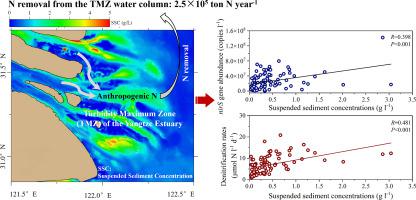Science of the Total Environment ( IF 8.2 ) Pub Date : 2021-05-14 , DOI: 10.1016/j.scitotenv.2021.147736 Yanling Zheng 1 , Lijun Hou 2 , Zongxiao Zhang 2 , Jianzhong Ge 2 , Maotian Li 2 , Guoyu Yin 3 , Ping Han 1 , Hongpo Dong 2 , Xia Liang 2 , Juan Gao 2 , Dengzhou Gao 2 , Min Liu 3

|
Estuarine systems are important sites of eliminating reactive nitrogen (N) delivered from land to sea. Numerous studies have focused on N cycling in estuarine sediment. However, the N elimination role of suspended sediments in estuarine turbid water column, which might provide anaerobic microenvironment for N loss, is rarely considered. This study examined the community dynamics and activities of denitrifying and anaerobic ammonium oxidation (anammox) bacteria in the water column of the turbidity maximum zone (TMZ) of the Yangtze Estuary, using molecular and 15N isotope-tracing techniques. Results showed that the anammox bacterial community was dominated by Candidatus Kuenenia and Candidatus Brocadia in the TMZ water column, while the main nirS-harboring denitrifiers were affiliated with Rhodobacterales. The denitrifying nirS gene was two orders of magnitude more abundant than anammox bacterial 16S rRNA gene, ranging from 1.77 × 105 to 1.42 × 108 copies l−1 and from 7.68 × 104 to 4.27 × 106 copies l−1, respectively. Compared with anammox, denitrification, with rates of 0.88 to 20.83 μmol N l−1 d−1, overwhelmingly dominated the N removal in the TMZ water column and was significantly correlated to suspended sediment concentrations (SSC). Based on the measured N removal rates, it was estimated that about 2.5 × 105 ton N was annually removed from the TMZ water column, accounting for approximately 18.5% of the total inorganic N (TIN) discharged from the Yangtze River. Overall, this study implies the importance of estuarine turbid water column in controlling N budget, and also improves the understanding of N loss mechanisms in estuarine TMZ systems.
中文翻译:

水柱对河口浊度最大区(TMZ)脱氮的贡献被忽略
河口系统是消除从陆地向海洋输送的反应性氮(N)的重要场所。许多研究集中于河口沉积物中的氮循环。然而,很少考虑河口混浊水柱中悬浮沉积物的氮消除作用,这可能为氮的损失提供厌氧微环境。本研究使用分子和15 N同位素示踪技术研究了长江口浊度最大区(TMZ)水柱中反硝化和厌氧铵氧化(anammox)细菌的群落动态和活动。结果表明,在TMZ水柱中,厌氧菌的细菌群落主要由Candidatus Kuenenia和Candidatus Brocadia组成,而主要的nirS则占优势。携带有反硝化作用的反硝化细菌与红细菌属细菌有关。反硝化的nirS基因比厌氧细菌16S rRNA基因丰富两个数量级,范围分别为1.77×10 5至1.42×10 8拷贝l -1和7.68×10 4至4.27×10 6拷贝l -1。 。与厌氧氨氧化相比,反硝化以0.88至20.83μmolN l -1 d -1的反硝化作用在TMZ水柱中的脱氮作用占绝对优势,并且与悬浮沉积物浓度(SSC)显着相关。根据测得的氮去除率,估计约为2.5×10每年从TMZ水塔中去除5吨氮,约占长江排放的无机N(TIN)总量的18.5%。总的来说,这项研究暗示了河口混浊水柱在控制氮预算中的重要性,并增进了对河口TMZ系统中氮损失机理的认识。











































 京公网安备 11010802027423号
京公网安备 11010802027423号